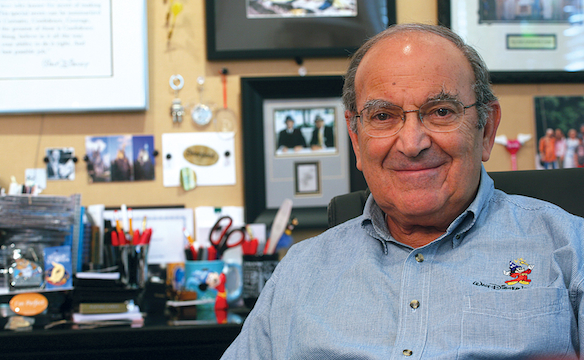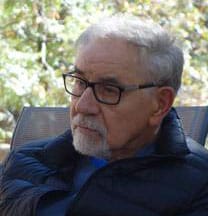 Marty Sklar
Marty Sklar In 2001, Martin (Marty) Sklar, now 79, was officially recognized as a “Disney Legend” — The Walt Disney Co.’s version of the Hall of Fame. In 2009, another exclusive distinction was bestowed on the low-key leader who had for decades guided Walt Disney Imagineering (WDI), the group that designs and constructs Disney’s theme parks and resorts worldwide: On his final day before retiring, Sklar was honored with a window dedicated to him on Disneyland’s Main Street.
Sklar, who is Jewish and grew up in Southern California, recently chatted with the Journal about his years at Disney and about some personal memories of Walt himself — including the widely disseminated rumor that Disney was anti-Semitic.
The story began in the spring of 1955, toward the end of Sklar’s junior year at UCLA, when he applied for a program that sent about a dozen students to India every summer.
“The whole idea was to show America in a different light from the way it was shown in the media,” Sklar said. “So they picked students who were from a variety of religious backgrounds, and two of them were always Jewish. I was in the running, but in the end, I wasn’t chosen.”
Although Sklar was disappointed, he was buoyed when he was tapped to become — for his upcoming senior year — editor-in-chief of the Daily Bruin, then, as now, the campus newspaper.
It was because he was in charge of the Bruin — and because he wasn’t in India — that Sklar got the opportunity that would change his life and set the trajectory of his career.
“It was June 1955,” Sklar said, “a month before Disneyland was set to open. I received a call to come in for an interview at Disney, with the head of marketing. It turns out that they wanted to put out a tabloid newspaper to be sold at Disneyland’s Main Street, so they hired me to do that.
“Finishing every park — since then, I’ve been involved with all of them — is chaos, especially at the end. But Disneyland in Anaheim was the first one, so it was even crazier because it had never been done before. … Here we were, two weeks before Disneyland was scheduled to open, and it was total chaos.
“It was at that time that I was called in to have a meeting with Walt, the Walt Disney, to present my concept for the tabloid. Remember: I was 21; I’d never worked professionally, still a student at UCLA. … I was plainly scared as hell. If it was no good, I was out the door; they’d find some professional to do it.
“But Walt liked what I presented, and that was the start of my 54 years at Disney. … If you have a turning point in life, that was mine.
“I’ll tell you what I learned from that meeting,” Sklar continued. “First, I was shocked that Walt had time for this little thing: a 10-cent tabloid to be sold on Main Street. But, like with everything he did, there was always enormous attention to detail.
“And second, for Walt, Main Street was a real town. And every town, at the early part of the 20th century, had its own newspaper. So Disneyland, at that time, without its own newspaper, was not a complete story. That was what I learned: It’s the details that make the Disney parks work, that attention to detail. And you have to make it a complete story, which means striving to be accurate about whatever story you’re telling, down to the smallest details.”
During his first few years at Disney, still in his 20s, Sklar wrote a film about Epcot, the international-themed park adjacent to Disney World in Orlando, Fla. The film was titled “Experimental Prototype for a Community of Tomorrow.”
“That was probably the most interesting experience I had with Walt,” Sklar said, “because it required me to spend several meetings in his office, just the two of us, and I still have pages of notes from one of those meetings. When I look back on it, I can see that he wrote the script of that film. I put the words on paper, but it was really his thoughts.
“He was so clear — so absolutely crystal-clear — about what he intended. And the big thing, and I have it on about three different pages of my notes, he kept repeating: ‘I want to meet the needs of people. I want to meet the needs of people …’ It just permeates everything that Disney does.”
Putting Sklar’s Disney lessons, lore and anecdotes inside the covers of a book has been one of his projects since his retirement in 2009. And now, the Disney imprint has just released “Dream It! Do It! My Half-Century Creating Disney’s Magic Kingdom.”
Sklar said one reason he wrote the book was to “debunk” many myths about Walt Disney, “including the one that he was supposed to have been anti-Semitic. … I never saw a shred of anti-Semitism in him,” Sklar said.
“I’ll tell you a story. During the High Holy Days, Walt tried to call me, and when I came back, I called his office and said to Tommie Wilck, his secretary, ‘What did Walt tell you when you told him I was celebrating Yom Kippur?’ She said that Walt told her, ‘Well, that’s where he should be, with his family.’
“So it’s a bunch of bull, but you know, I can see where it came from,” Sklar said. “Walt was from the Midwest, he wasn’t used to being around Jews. And then he came out here, [where] most of the people in the entertainment business were Jews, so he was the guy out in the cornfield; he was different, and I think that’s where it came from. It never came from anything he said. Not ever.”
The offices of the Imagineers are located on Disney’s Glendale campus, a nondescript industrial area with no animation-themed architecture or nostalgia-infused sculpture. You can drive through it without even realizing you’re on a Disney campus. In recent years, however, this area has been spiffed up somewhat, although it still consists largely of blocky, single-story warehouses.
The Glendale campus’ bland exterior, however, lies in contrast to the inventive work carried out inside, especially by WDI, which Sklar led for decades and continues to inspire. In a way, Sklar himself is similar to the Glendale campus: He cloaks his (literally) groundbreaking creativity within a self-effacing exterior. When Sklar became a Disney Legend, Roy E. Disney, Walt’s nephew, was quoted in the Los Angeles Times as saying that Sklar “is not interested in getting credit for anything … [yet] he has influenced everything we’ve ever done.”
In “Dream It! Do It!” Sklar writes about his final years at Disney, when he had the job of “ambassador,” teaching and preaching “Mickey’s Commandments,” which included Sklar’s rules for “leadership” and “followership.” Clearly, Sklar learned the first two commandments from Walt himself: “1. Know your audience,” and 2. “Wear your guests’ shoes.”
Occasionally, in these commandments — as if with a sly wink — Sklar’s Jewish roots emerge. For example: “Take time to teach — mentors are mensches.”
Indeed, during his years as Disney ambassador, Sklar expanded Mickey’s Commandments from 10, to 20, to 30, and eventually to 40. In his book — poking fun, perhaps, at his own low-key image — Sklar sends apologies “to God and Moses, who somehow managed to stop at 10.”
When asked about that, Sklar laughed. “Compared to me, Moses was a piker,” he said.























 More news and opinions than at a Shabbat dinner, right in your inbox.
More news and opinions than at a Shabbat dinner, right in your inbox.